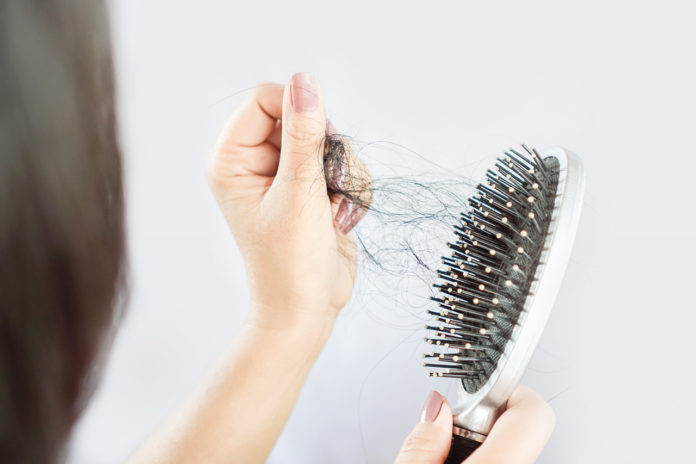Chronic, sustained exposure to stressors can profoundly affect tissue homeostasis, although the mechanisms by which these changes occur are mainly unknown. In a new study, scientists report about the biological mechanisms by which chronic stress impairs hair follicle stem cells. Their study confirms that chronic stress prompts hair loss.
Scientists discovered that stress puts hair follicles stem cells at rest, causing degeneration of the follicle or the hair. By identifying specific cell types and the responsible molecule that relays the stress signal to the stem cells, scientists have shown that this pathway can be targeted to restore hair growth.
Ya-Chieh Hsu, the Alvin and Esta Star Associate Professor of Stem Cell and Regenerative Biology at Harvard and senior author of the study said, “The skin offers a tractable and accessible system to study this important problem in depth, and in this work, we found that stress does actually delay stem-cell activation and fundamentally changes how frequently hair follicle stem cells regenerate tissues.”
Scientists studied a mouse model of chronic stress and found that hair follicle stem cells stayed in a resting phase for a very long time without regenerating tissues. This causes upregulation of corticosterone.
When scientists gave mice corticosterone, it reproduced the stress effect on the stem cells.
Hsu said, “This result suggests that elevated stress hormones indeed have a negative effect on hair follicle stem cells. But the real surprise came when we took out the source of the stress hormones.”
Under normal conditions, the regeneration of hair follicles slows with increasing age. In their experiments, scientists removed the stress hormones, causing the stem cells’ resting phase short and increased growth phase to regenerate hair follicles throughout their life, even when they were old.
Hsu said, “So even the baseline level of stress hormone that’s normally circulating in the body is an important regulator of the resting phase. Stress essentially just elevates this preexisting ‘adrenal gland–hair follicle axis,’ making it even more difficult for hair follicle stem cells to enter the growth phase to regenerate new hair follicles.”
After finding the connection between stress and hair loss, scientists tend to determine the biological mechanism underlying the connection.
Sekyu Choi, the lead author of the study, said, “We first asked whether the stress hormone was regulating the stem cells directly and checked by taking out the receptor for corticosterone, but this turned out to be wrong. Instead, we found that the stress hormone actually acts on a cluster of dermal cells underneath the hair follicle, known as the dermal papilla.”
Dermal papilla is essential for activating hair follicle stem cells. However, in previous studies, when stress hormone levels were altered, it doesn’t change factors secreted from the dermal papilla. Instead, stress hormone prevented dermal papilla cells from secreting Gas6.
Choi said, “Under both normal and stress conditions, adding Gas6 was sufficient to activate hair follicle stem cells that were in the resting phase and to promote hair growth. In the future, the Gas6 pathway could be exploited for its potential in activating stem cells to promote hair growth. It will also be very interesting to explore if other stress-related tissue changes are related to the stress hormone’s impact on regulating Gas6.”
Scientists think the requirement of further study before applying it to humans. Despite the fact that the stress has detrimental impacts on both hair follicle stem cells and melanocyte stem cells, but the mechanism is different.
Stress depletes melanocyte stem cells directly via nerve-derived signals, while stress prevents hair follicle stem cells from making new hairs indirectly via an adrenal-gland-derived stress hormone’s impact on the niche. Because hair follicle stem cells are not depleted, it might be possible to reactivate stem cells under stress with mechanisms such as the Gas6 pathway.
Hsu said, “When looking for factors that control stem cell behaviors, normally we would look locally in the skin. While there are important local factors, our findings suggest that the major switch for hair follicle stem cell activity is actually far away in the adrenal gland, and it works by changing the threshold required for stem cell activation.”
“You can have systemic control of stem cell behavior located in a different organ that plays a really important role, and we are learning more and more examples of these ‘cross-organ interactions.’ Tissue biology is interconnected with body physiology. We still have so much to learn in this area, but we are constantly reminded by our findings that in order to understand stem cells in the skin, we often need to think beyond the skin.”
Journal Reference:
- Choi, S., Zhang, B., Ma, S. et al. Corticosterone inhibits GAS6 to govern hair follicle stem-cell quiescence. Nature (2021). DOI: 10.1038/s41586-021-03417-2
